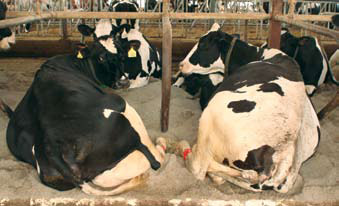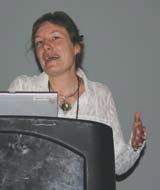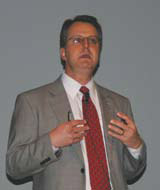Conference fosters dialogue on cattle welfare

Months after an undercover activist filmed abusive handling of dairy cows at a California slaughterhouse, leading to a massive beef recall, bovine practitioners still have the incident in mind during every conversation about animal welfare.
Even before the video, the American Association of Bovine Practitioners already had chosen the well-being of dairy and beef cattle as the subject of general sessions at the 2008 AABP conference.
At the Sept. 25-27 meeting, many speakers said veterinarians need to address specific welfare issues while helping producers talk to consumers about the benefits of modern livestock systems.
Charlie Arnot, president of CMA Consulting and chief executive officer of the Center for Food Integrity, spoke during the first general session about "Protecting Your Freedom to Operate: How do we keep our message from being lost in translation?"
Arnot said consumer trust in food producers to care for livestock depends on the influence of others, the competence of producers, and consumers' confidence in producers to do what's right.
"Let's talk about who we are today in a way that builds public trust," he said. "Science should be the foundation of decision making, but we need to do a better job talking about values and ethics."
Arnot said a sustainable livestock production system must balance science, ethics, and economic viability.
Animal well-being
The second general session focused on the well-being of calves, with speakers addressing topics such as dehorning and castration. The third general session examined some of the broad welfare issues facing dairy and beef practitioners—as well as the idea of welfare audits.

Dr. Becky Whay of the University of Bristol gave an overview of pain and lameness in cattle before describing the Healthy Feet Project in the United Kingdom. About half of U.K. dairy cattle become lame each year, she said, with 20 percent lame at any one time.
Dr. Whay said the Healthy Feet Project has seen some success by asking farmers what changes they want to make to prevent lameness and then asking farmers to commit to making those changes.
"Just because it's difficult doesn't mean it's not one of the most important things that we can do to improve herd-level welfare," she said.
Dr. Dan Weary of the University of British Columbia spoke about assessing and preventing lameness. He said his research has found that scoring a cow's gait is one way to measure lameness.

Science should be the foundation of decision making, but we need to do a better job talking about values and ethics.
— CHARLIE ARNOT, PRESIDENT, CMA CONSULTING, AND CHIEF EXECUTIVE OFFICER, CENTER FOR FOOD INTEGRITY
Dr. Weary's research also has found that methods for preventing or reducing lameness include putting cows on pasture, providing dry bedding in indoor housing, and finding the optimal position for neck rails in stalls.
"A little management goes an awful long way," he said.
Dr. Terry Homan of Valley Veterinary Clinic in Seymour, Wis., shared his perspectives on animal well-being as a dairy practitioner. He recalled discouraging situations in which housing issues—such as wet conditions and overstocking—contributed to high morbidity and mortality rates.
"I don't think we can claim ignorance of the problems I've described," he said.
Dr. Homan recently started his own milk brand with an emphasis on husbandry, even as he continues in dairy practice.
Relevant to both dairy and beef cattle, Dr. Tom Noffsinger spoke about training workers in low-stress handling techniques.
"Every human interaction with these cattle has the potential to be positive or negative," he said.
Dr. Noffsinger said low-stress handling is all about observing cattle behavior and desensitizing animals to unfamiliar processes. Cattle want to be able to see the handlers, so handlers should always work with animals from the front rather than yelling from behind. In general, handlers need to move slowly and think fast.
Dr. Scott Reynolds provided an update about the welfare aspects of a feedyard self-assessment that the Beef Quality Assurance program has been developing for veterinarians and producers.
"We need to find a way to prove we're doing the right thing," he said.
The draft feedyard self-assessment has sections for welfare issues, such as abuse or neglect by workers, and for measurements relevant to welfare, such as a mud score. Dr. Reynolds, chairman of the project's working group, said the hope is that the BQA self-assessment will become the basis of all feedyard audits.
Dr. Whay returned to the podium to describe welfare assessments and audits in the United Kingdom.
To access the marketplace, Dr. Whay said, U.K. farmers usually need to register with one or more voluntary "farm assurance schemes." The groups that create the programs set standards in areas such as animal welfare and food safety, and inspectors audit farms for compliance with the standards.
From birth to death
The last general session during the AABP conference revolved around how to provide a comfortable life and kind death for calf and cow. Speakers discussed welfare-friendly housing, euthanasia in the field, and welfare at the slaughterhouse.
Dr. Ken Nordlund of the University of Wisconsin-Madison spoke about welfare-friendly calf housing. He noted some of the trade-offs for calf health and welfare in various housing systems.
"Social interaction goals may interfere with disease control," he said.
Dr. Nordlund added, though, that group housing of calves early in life might lead to less disease in group housing after weaning.
Erika L. Voogd, president of Voogd Consulting in West Chicago, Ill., spoke about welfare at the slaughterhouse.
Voogd said holding areas must provide clean water, ample space, and shade on warm days. She said the processing plants should train employees in handling, post signs to remind employees about proper handling techniques, and keep relevant records.
"Prevent the undercover opportunity," Voogd said, by fixing any problems.